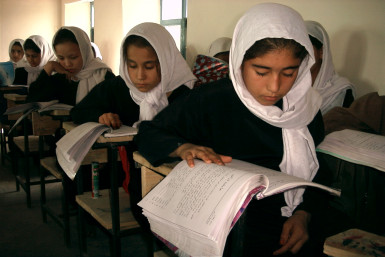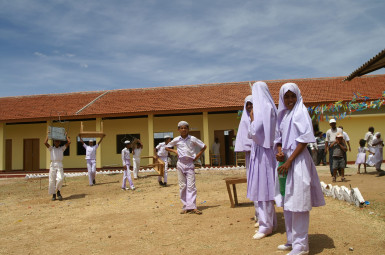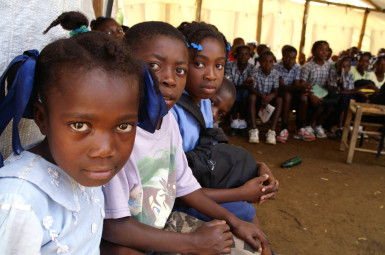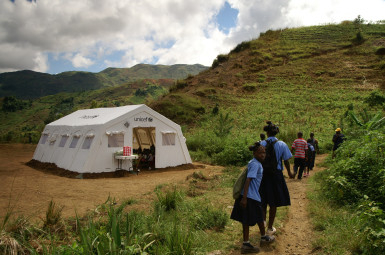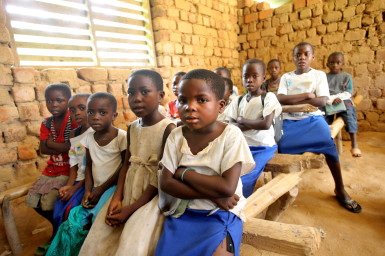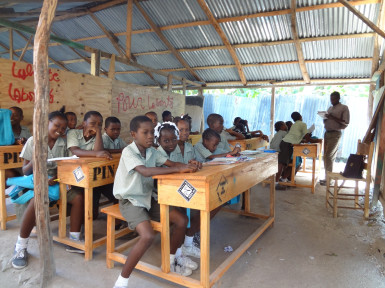Education in Emergencies: 25 years of PIN commitment to children’s futures
Published: Oct 31, 2025 Reading time: 10 minutes Share: Share an articleConflict, epidemic, and the climate crisis impact all children. In countries affected by emergencies, children lose safety and routine. Without access to education, they risk losing their futures. For 25 years we have worked to prevent this.
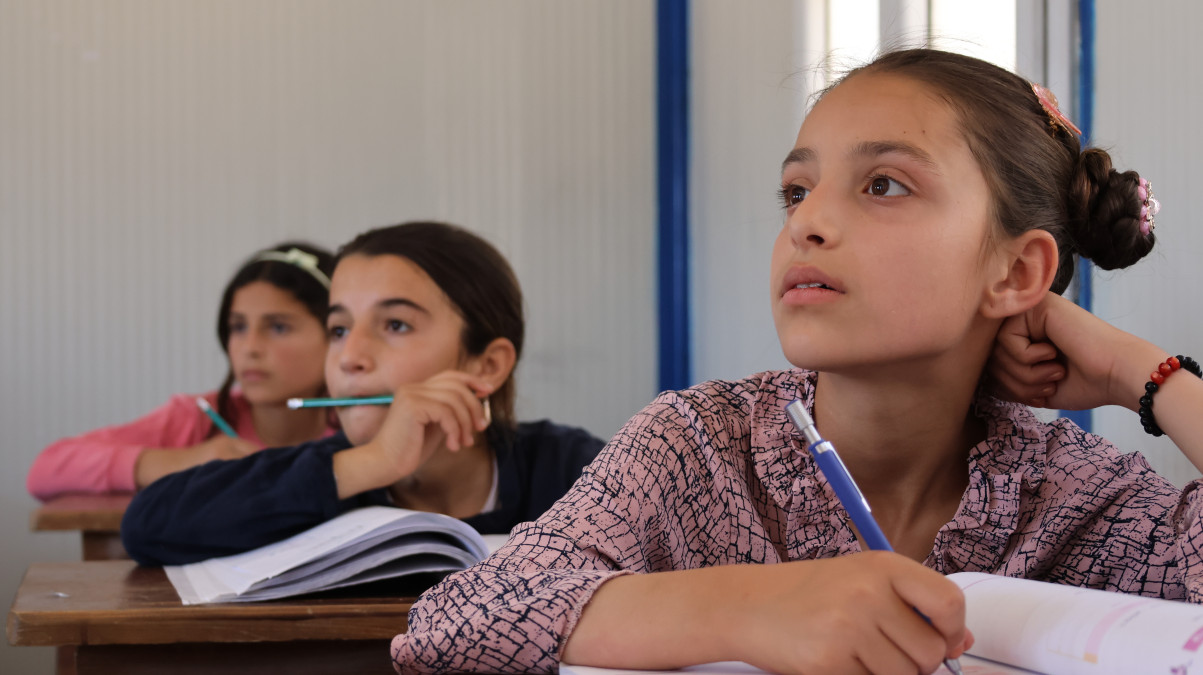
In 2025, 234 million school-aged children in crisis contexts need educational support, says Education Cannot Wait (ECW). This equals the populations of Germany, France, the United Kingdom, Czech and Slovak Republic combined. As many as 85 million children who are out of school, and 127 million who are in school, are not achieving minimum proficiency in math or reading. The number of school-aged children affected by crises has increased by at least 35 million over the past three years, according to ECW.
Lifesaving interventions as investment in the future
For 25 years we have systematically supported children affected by conflicts, natural disasters, and other crises in various parts of the world. “From small-scale projects in the early 1990s and 2000s, to over 120,000 children supported in 2024 alone, Education in Emergencies has become a key focus for us. We are an experienced and reliable partner for the communities we work with—as well as for donors,” says Laurel Jansury, People in Need’s Education in Emergencies Advisor.
“For us, Education in Emergencies is a lifesaving, protective intervention that keeps children physically and psychologically safe during a crisis. It is also a transformative investment with the potential to unlock positive impacts for generations to come and build long term resilience for children and communities,” she adds.
Since 2000, we’ve supported 1,211,680 children and 5,467 education spaces across 30 countries. We rehabilitated 1,501 education spaces across 21 countries and supported 36,588 teachers and 21,246 parents and caregivers. Behind these numbers are stories of children, their parents, and their teachers striving to do their best in difficult circumstances.
Ukraine: Learning under air raid sirens
In today’s Ukraine, childhood and education look very different. Some children go to school with backpacks and flashlights ready to rush to a shelter at the sound of an air raid siren. Others join lessons online from frontline settlements where schools remain closed. Many switch between in-person and remote classes, depending on how close the next attack might be. Yet, learning continues.
At Sakhnovshchyna Lyceum in Kharkiv Oblast, lessons often take place underground. “When there’s an air raid siren, we don’t waste time moving to a safer place. We exhale and continue with the lesson,” says Tetiana Pryadko, a teacher’s assistant. “Live communication, teacher support, and the smiles of children - these are things that no online class can replace.”
For her son Roman, a first-grader, the school shelter rehabilitated by People in Need means more than safety. It means friendship, play, and the chance to finally learn in person. Because of the war and the pandemic, Roman never experienced kindergarten, but now, for the first time, school feels almost normal.
Syria: A chance for education and new friends
Majed was displaced by the war in Syria and for a long time could not attend school. “We have been living here for 4 years. I did not know how to read and write,” he says. Close to his village we built and equipped a Temporary Learning Centre (TLC) and Majed has been attending it for 6 months. “Now, I have learned how to write and spell. I will keep studying. I want to be a doctor because my mother is sick. Her eyes are hurting her, so I would like to be a doctor. I told her that when I grow up, I will become an optician,” he adds.
The TLC where he learns how to read, write and count, not only is preparing him to transition to a formal school, but also gives him new friends. “I used to see other children making friends, but I did not have any. When I came here, I learned how to make them. Now I have had wonderful friends,” he says.
25 years of restoring education after war, floods, earthquakes, and tsunamis
Supporting Education in Emergencies was already an integral part of our humanitarian response in second half of 1990s with the reconstruction of schools in Bosnia and Herzegovina and Kosovo after the wars and in Romania supporting Czech compatriots in the Romanian Banat. Our first comprehensive foray into Education in Emergencies was during the Second Chechen War. We reconstructed schools in the Chechen capital, Grozny, and managed temporary school network in camps for internally displaced people in Ingushetia.
One in six children globally live in conflict zones
Over 470 million children—more than one in six globally—live in areas affected by conflict according to UNICEF. Education has been severely disrupted in these conflict zones—by the end of 2024, more than 52 million children in countries affected by conflict are estimated to be out of school. Girls in conflict-affected countries are nearly 2.5 times more likely to be out of school compared to girls in other places.
In Afghanistan, after the Taliban was ousted in 2001, we immediately began supporting education and it soon became one of the main pillars of our work in the country. By 2007, we had constructed and rehabilitated 81 schools, and we also focused on teacher training, non-formal education for girls, rural education, and literacy courses for adults. Currently we have established 150 Community-Based Education (CBE) classes for 5,250 out-of-school children.
After the devastating 2002 floods in the Czech Republic, we reconstructed several schools in the most affected regions. At the same time, we supported the education sector in Iraq with reconstruction of primary schools, colleges, and dorms for university students. In 2003, we rehabilitated schools in Ethiopia and Armenia; and in the following year we responded with education support for the Iranian city of Bam which was struck by a powerful earthquake at the very end of the year, where, we established centres for children and teenage girls.
In 2005, we went to Sri Lanka and established a complex education programme focused on building or rebuilding schools in places impacted by the 2004 Indian Ocean tsunami—which also struck at the end of this year. Our other education-related activities included vocational training, development of the school and pre-school sectors and English language training for teachers.
In 2008, we stepped into education sector in Democratic Republic of the Congo to support education in rural areas. In 10 years, we built 65 new classrooms and renovated 90 classrooms, enabling thousands of children to attend school.
Half of all out-of-school children live in only 8 countries
Half of all out-of-school children in emergencies are concentrated in eight countries: Afghanistan, Democratic Republic of the Congo, Ethiopia, Mali, Myanmar, Nigeria, Pakistan and Sudan.
In 2010, Pakistan was hit by some of the worst floods in its history. We immediately responded, participating in the reconstruction of buildings and providing equipment to 12 damaged schools. The same year, a devastating earthquake hit Haiti and part of our response was the reconstruction of education spaces. Immediately after the earthquake, we established 37 tent-schools and later we built and equipped 24 schools for 3,350 children. In addition, we supported 850 teachers and provided 40,000 children with stationery.
2012 saw the establishment of our largest Education in Emergencies programme to date in Syria, which continues to operate today. In 2024, we supported 80 schools and learning centres, reaching over 65,000 students with catch-up programmes, remedial education, and psychosocial support classes to help children rebuild their futures despite years of conflict.
In November 2013, Typhoon Haiyan, became the strongest typhoon ever to hit the Philippines. It left 4 million people without a roof over their heads. Schools were twice as frequently damaged compared to other public buildings, and in a third of villages they were totally dysfunctional. By the end of 2014, we repaired 128 classrooms in 35 schools, and 4,400 children can continue their education.
Violence against education continues to escalate
“Between 2022 and 2023, there were around 6,000 attacks targeting students, educators, and educational institutions. The use of schools for military purposes rose by 20%, and over 10,000 students were killed, abducted, arrested, or harmed.
Attacks on education in conflict zones have reached alarming levels. Over the past year, there was a 44% increase in attacks on schools, leading to the death, abduction, and traumatisation of thousands of students and teachers. These violations threaten not only individual lives but the future of entire communities.”
After the devastating 2015 earthquake in Nepal, we provided the affected communities with tents that served as temporary schools and health centres. Later we rehabilitated and equipped schools damaged by the earthquake.
In 2014, when conflict erupted in eastern Ukraine, we rehabilitated damaged schools and kindergartens and provided them with water. We also provided psychosocial support to adults and children to cope with the effect of war and traumatic events. After the Russian invasion of Ukraine in February 2022, humanitarian needs and our response expanded massively. More than 3,800 educational institutions have been damaged since then, and millions of children face disrupted learning. Many are forced to study in underground shelters or online only. Beyond access to classrooms, children also need psychosocial support to cope with distress and they need safe spaces where they can learn, play, and simply feel like children again.
To date, we have opened 16 Digital Learning Centres and supported 37 schools for 5,558 children and repaired 23 temporary spaces for over 25,000 children; 2,562 children attended catch-up classes, 12,125 children received psychosocial support, and 3,299 children are supported in child-friendly spaces.
Climate crisis is threatening access to education
According to the World Bank a staggering 400 million students have experienced school closures from extreme weather since 2022, with climate change disproportionately impacting those boys and girls who are displaced or affected by conflicts, violence, and other humanitarian crises.
In 2024 alone, climate-related disasters like heatwaves, tropical cyclones, storms, floods, and droughts disrupted schooling for 242 million children across 85 countries, says UNICEF.
In 2024, in Gaza we are supporting War Child Alliance, who alongside local partners provide urgent psychosocial assistance to distressed children and their families. When possible - in addition to household-level and community therapeutic sessions - trained staff organise structured recreational activities for children, where they can play and meet their peers in a safe and stimulating environment. In 2024 alone, we supported 15,803 children and their family members with psychosocial support.
Let us stop the crisis now
Just in 2024 we supported 123,902 conflict-affected children to continue their education, 4,153 teachers and other education personnel with financial and material support, and capacity development and 5,663 parents and caregivers with parenting skills and psychosocial support.
Alarming trends tell us that we need to stop this crisis—now. “Education is not just a right—children and their parents and caregivers prioritise it. The international community must urgently scale its support for Education in Emergencies efforts—politically and financially—to stop this crisis from worsening. We call on decision-makers to join the race against the rising needs and support children at risk of being left behind,” says Laurel Jansury. “We need to work together with education actors, donors and communities to secure the right to education for the 234 million children in crisis who are lacking quality education,” she adds.

